Live Bait Rigging
Fishing with Hooks, Sinkers, Bobbers & Basic Rigging
With all of the advancements made today in the fishing world with “new lifelike fancy expensive lures that flash and swim on their own” sometimes just a plain ol’ hook, weight and bobber with a hunk of worm, minnow or leech will catch more fish.
One of the biggest mistakes made by the novice angler is over rigging, using too large of a hook, heavier than needed weight with a oversized bobber presenting a unnatural look, reduces the ability to detect fish strikes in their fishing presentation. The best application is to select the lightest possible terminal tackle suitable for the condition and the species of fish.
In this section we will review Terminal Tackle: Hooks, Weights, Bobbers (Floats) and Swivels. How they are used and properly rigged for a successful set-up.
Carry your Terminal Tackle
Get organized with a rig box with small compartments. That way you can find the appropriate hook, weight, bobber for most fishing situations.
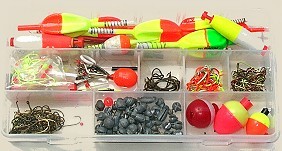
Fishing Hooks
As a rule, use the smallest hook possible. Small hooks allows the live-bait presentation to look natural. Small hooks also penetrate quicker than larger hooks upon the fish strike. Always test your hook for sharpness. Sharp hook points will catch more fish than dull hooks. To test your hook simply draw the hook point across your fingernail, a sharp hook will leave a light scratch and digs in to your nail.
A dull hook will skate across your nail with out digging in. When necessary touch up the hook point by using a hook file or sharpening stone, simply draw the hook sharpener against the point of your hook a few times (parallel to the shank) on the bottom, and then take a couple of quick strokes to each side of the hook.
Don’t be misled that new hooks out of the box are always sharp especially the cheap hooks that are made of soft poor quality steel. Even high quality hooks will dull over time and use by hitting rocks and debris in the water.
Another option is to use chemically sharpened hooks. Many quality hook manufactures offer a line of hooks that are made of higher grade steel and then dipped in a chemical bath which gives the hook a super sharp hook point. These hooks can be expensive compared to conventional hooks, but the advantage is a super sharp hook right out of the package. The bottom line is always use a sharp hook.
Hook Sizes
When it comes to hook sizes it tends to be little confusing. There is no standard when it comes to classifying a hook size, generally when a single number is used such as size 12 verses a size 8 the higher the number the smaller the hook.
The classification system ranges from 1 largest to 32 smallest. To make it more confusing hooks that are sized using a fraction type, for example 5/0 ( pronounced five – aught) compared to a 1/0 the sizing system is reversed so the higher the number the larger the hook. 1/0 is the smallest up to the largest hook at 19/0.
%AD1%
The Anatomy of a Fish Hook
The parts fish hook are referred as: It’s point- the sharp end that penetrates the fish’s mouth or flesh; the barb – the projection extending backwards from the point, that secures the fish from unhooking; the eye – the end of the hook that is connected to the fishing line or lure; the bend and shank – that portion of the hook that connects the point and the eye; and the gap – the distance between the shank and the point.
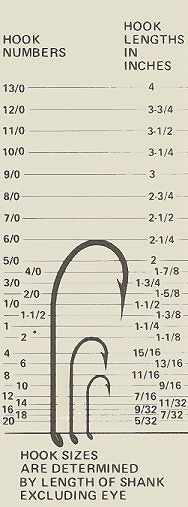

Popular Common Hook Types

Aberdeen
Light wire long shank hook, perfect for Panfish, Crappie and light biting Walleyes under a slip bobber or attached bobber rig. The light wire limits excessive puncturing on minnows which helps them live longer on the hook, the long shank allows the angler easy removal of the hook from panfish that tends to swallow the bait.

Bait Holder
The bait holder hook is one of the most popular live bait hook styles today, the additional barbs on the shank holds the bait more effectively, such as night crawlers leeches and red worms.

Circle
Circle hooks are a excellent choice for live bait catch and release anglers. Upon a fish swallowing your bait, the inward bend of the hook point allows the hook to slide along the inside of the fish’s throat until it reaches the mouth. A sharp pulling hook set is not required, just maintain tension and the fish will hook itself in the corner of the mouth as the fish moves away. The lip hook rate using a circle hook is about 95% it also reduces the mortality rate of fish to be released to fight another day. Very popular hook for Catfish, Sturgeon and Muskies anglers.

Egg
Commonly called salmon egg hook, designed with a turned up eye and offset bend, so the hook rides upward along with the placement of a barb on the shank which holds the bait. The salmon egg hook is used primarily for drift fishing along current by using natural or imitation salmon eggs, spawn sacs, worms and grubs for Salmon and Trout.

Octopus
The extra gap and rounded shape of Octopus hooks are very popular and used for most species of fish. The Octopus is ideal for rigging cut bait for Catfish or Salmon, minnows for Bass, Pike and Walleyes and are good choice for building crawler harnesses. They are available in a assortment of painted or metallic colors.

Rotating
A special compound curve on the offset/rotating hook automatically turns when a fish bites on the bait. The sweeping rotational curve places the point in position for penetration from any angle. The offset/ rotating hook twists, holds bait better and hooks fish better.

Treble
Treble hooks are a single eye of three hooks fused together with three shanks evenly spaced. The treble is mainly used on artificial lures and spoons attached by using a split ring. Treble hooks today comes in a assortment of colors as well as feathers tied on as a trailer/teaser hook on lures.
%AD2%

Weedless
The weedless hook has a light wire wrapped on the shank formed in a loop that covers the point of the hook. This allows the hook to be fished in weeds logs, trees, stumps, rocks and lily pads. Upon a fish striking the bait the wire compresses exposing the hook point.

Offset/Worm
Worm hooks are used for fishing soft plastic’s lures. The front bend on a worm hook is used to lock lures such as worms and lizards from moving down the shank by simply inserting the hook point into the head of the lure down about a 1/4 inch. Bring the hook point out of the lure, and pull the shaft of the hook through until the eye is at the head, turn the hook straight and insert the hook point into the body, adjust the eye so it is just inside the lure. Used on Texas and Carolina Rigs.
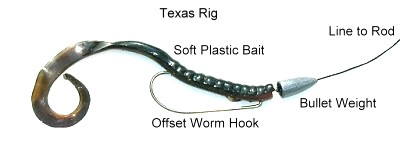
Texas Rig
The Texas rig is adaptable to all types of soft plastics from worms to lizards and grubs that can be fished in extremely dense vegetation and brush. To learn more about how to rig and fish the Texas Rig please Click Here
Fishing Weights (Sinkers)
Fishing weights (sinkers) are made from two basic materials lead and steel. The two types of sinkers are: attached on the line by pinching, twisted on using rubber insert or tied directly to your line (Bottom Bouncers / Bead Chain Sinkers). The other is sliding: which allows the fishing line to slide or pass through the weight from a hole or a eyelet. The same principle applies in using sinkers for your set-up use the lightest possible sinker in order to detect fish strikes.
Popular Common Sinkers / Weights Types

Split Shot
Pinches easily onto your line where you want to set depth at. Removes just as easy by pinching the other end. Used for live bait and lures.
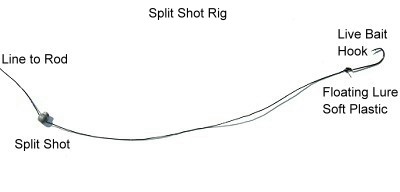
Split Shot Rig
This is about as basic as you can get on a rig. The nice thing is, you don’t have to retie any knots to change the sinker position on the line; just pinch it on and off. To learn more about how to rig and fish the Split Shot Rig please Click Here
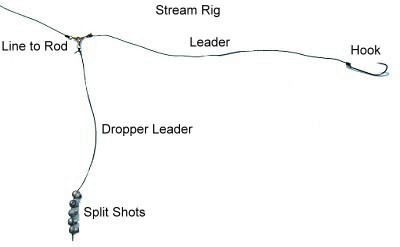
Stream Rig
The stream rig also known as a drift rig are used commonly by steelhead, salmon and walleye anglers in certain situations, such as in small streams with light current or when drift fishing in relatively shallow water. To learn more about how to rig and fish the Stream Rig please Click Here
![]()
Rubber Core
Attach to line thorugh the slot in the sinker and twisting the inner rubber core around line to secure it. Used when heavier weight is required.

Drop Shot
Many tackle companies manufacture designed drop shot weights, round or rectangular of lead or tungsten and come with a tie on clip on the top. The weights range from 1/8oz to 1/2oz.

Drop Shot Rig
The drop-shot rig is a finesse technique that has been made popular by the bass fishing community, walleye and panfish anglers as well are now using the drop shot with many successes. To learn more about how to rig and fish the Drop Shot Rig please Click Here
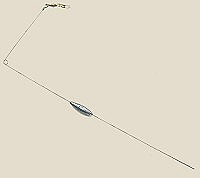
Bottom Bouncer
The bottom bouncer is an effective rigging tool while trolling or drifting presenting the lure/bait rig above snag laced bottom of small rocks, logs, over mud/sand flats, or open basins. A weighted wire feeler arm minimizes hang-ups while riding upright across underwater structure deflecting snags. To learn more about how to rig and fish the Bottom Bouncer Rig please Click Here
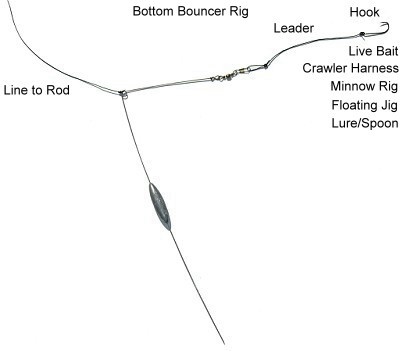
![]()
Bead Chain / Trolling
Great for trolling lighter lures with out having to use lead core line or downriggers

Bank
Similar to the walking sinker but comes in heavier weights 1oz-6oz Squared edge design helps you keep your bait where you want it.

Bullet
As the name implies it is shaped like a Bullet used on Texas rigs in front of the worm, lizards or on Carolina rigs, with it’s pointed nose it slides easily through the weeds or wood with out getting snagged. Weight Sizes 1/8 oz to 1 oz.
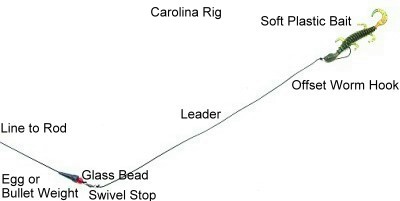
%AD5%
Carolina Rig
The Carolina rig is a popular and effective way to rig for bass. Just about any soft plastic can be used when Carolina rigging. To learn more about how to rig and fish the Carolina Rig please Click Here

Casting
All around general sinker used on many rigs, the top loop makes it easy to tie on or let the weight slide up and down the line. Weight Sizes 1/8 oz to 1 oz.
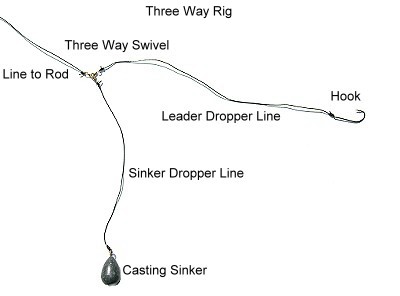
Three Way Rig
The three way rig receives its name from the main swivel used on the rig. It is also recognized as the wolf river rig. To learn more about how to rig and fish the Three Way Rig please Click Here
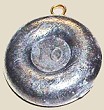
Disc
Used in fast water currents lays flat on the bottom where snags are a problem. Weight Sizes 1/2 oz to 4 oz.

Egg
The egg sinker is used on multiple rigs, as a sliding sinker or pegged to function as a stationary weight. Weight Sizes 1/8 oz to 1 oz.

Flat
Also known as a No Roll this flat sliding sinker planes right to the bottom and hold for use in heavy current. Weight Sizes 1oz to 8 oz

Pyramid
Great sinker for fishing swift rivers and heavy surf that have a soft bottom (mud and sand) the corners dig in keeping the weight stationary. Weight Sizes 1 oz to 8 oz.

Walking
A very popular walleye angler sinker. A rectangular sinker with rounded outside edges a top eye for the line with the bottom slightly wider and larger in size than top, holding more weight. The bottom is also rounded and bent upwards. This allows the sinker to “walk” on the bottom over rocks and rubble reducing the chance of snagging. The semi-flat design also prevents it from rolling in faster currents.
Weight Sizes 1/8 oz to 1 1/2 oz.
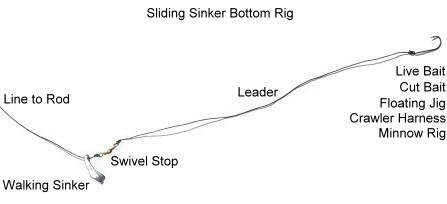
Sliding Sinker Bottom Rig
The sliding sinker bottom rig is the most popular and versatile rig for live bait fishing. Dependent on what part of the country your from and the species of fish you’re targeting it has many names the most common is the trade name Lindy Rig. To learn more about how to rig and fish the Sliding Sinker Bottom Rig please Click Here
Swivels
Swivels are a simple but yet important part on your fishing gear when it comes to rigging. The swivel keeps your line from twisting, acts as a weight stop on your line along with spreading bottom rigs ( 3-way swivel) for proper presentations. Swivels are also used as a component on a leader to attach your line.

Barrel

Ball Bearing

Three Way

Snap Swivel
Fishing Bobbers (Floats)
Fishing with a bobbers is one the most common and simple set-ups. The bobber or float presents the bait at a pre set depth and acts as a strike indicator when a fish bites. There are a variety colors, shapes and size bobbers available today, lighted or glow for night time fishing, slip bobbers that the fishing line passes through for deep water fishing and the fixed bobber that uses a spring lock or snap for shallow water fishing.
Popular Common Bobbers (Floats)
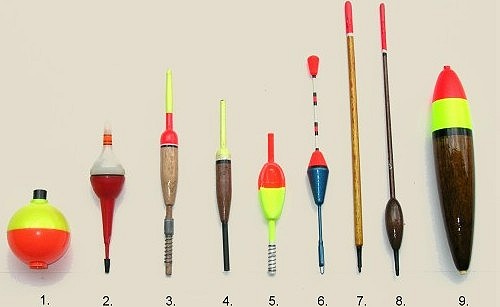
1. Round Attached 2. Lighted Slip 3. Weighted Spring Attached 4. Glow Slip 5. Slip
6. Antenna Slip 7. Shy/Light Bite Slip 8. Waggler Slip 9. Large Bait Slip

Sliding Slip Bobber Rig
The slip bobber can be fished at any depth, it is designed to move (slide) up and down the line and will not interfere with casting or landing a fish. To learn more about how to rig and fish a Slip Bobber please Click Here.
Copyright 2011 Outdoor Network All rights reserved. This material may not be copied, published, broadcast, rewritten, or redistributed.
